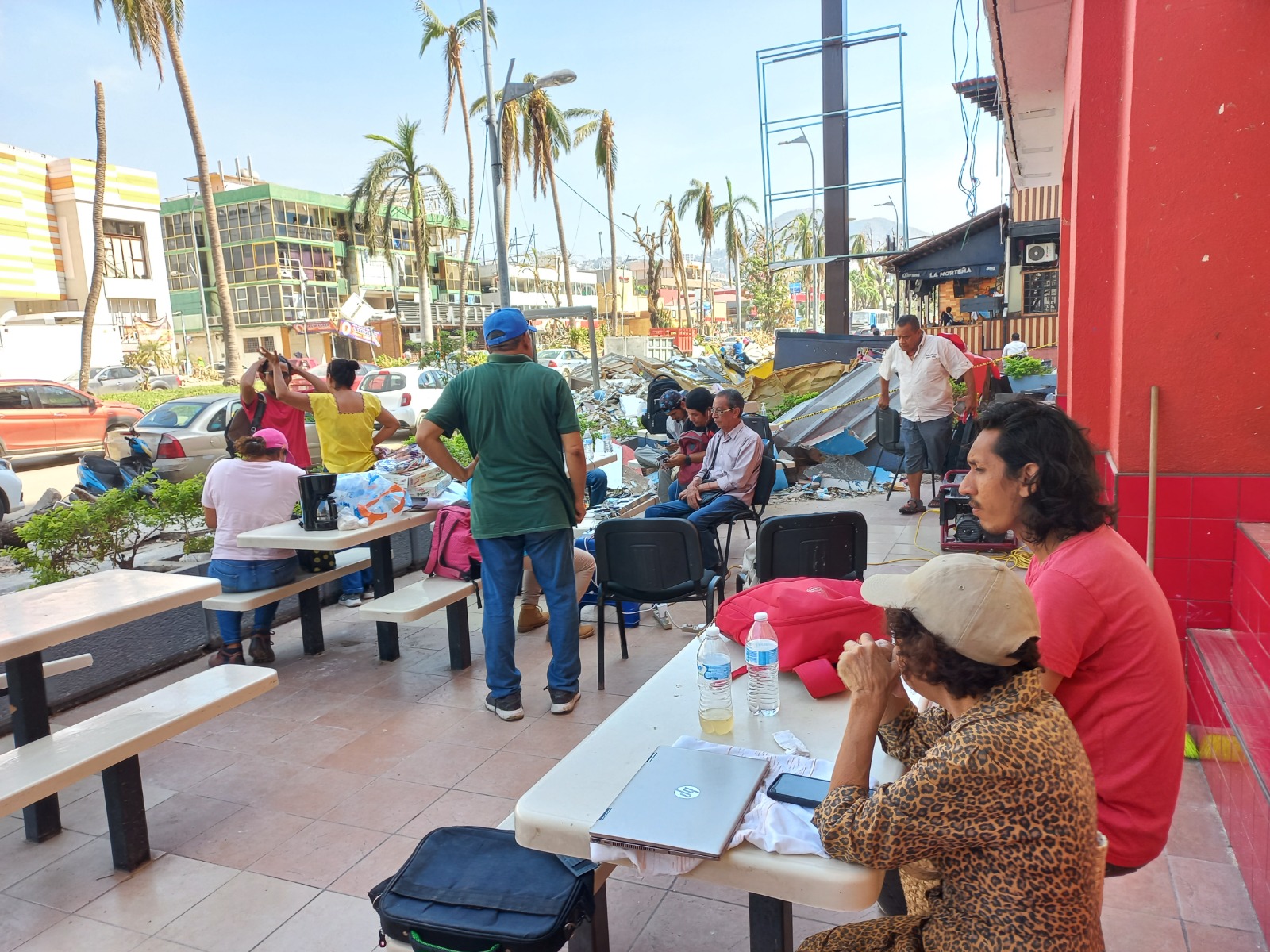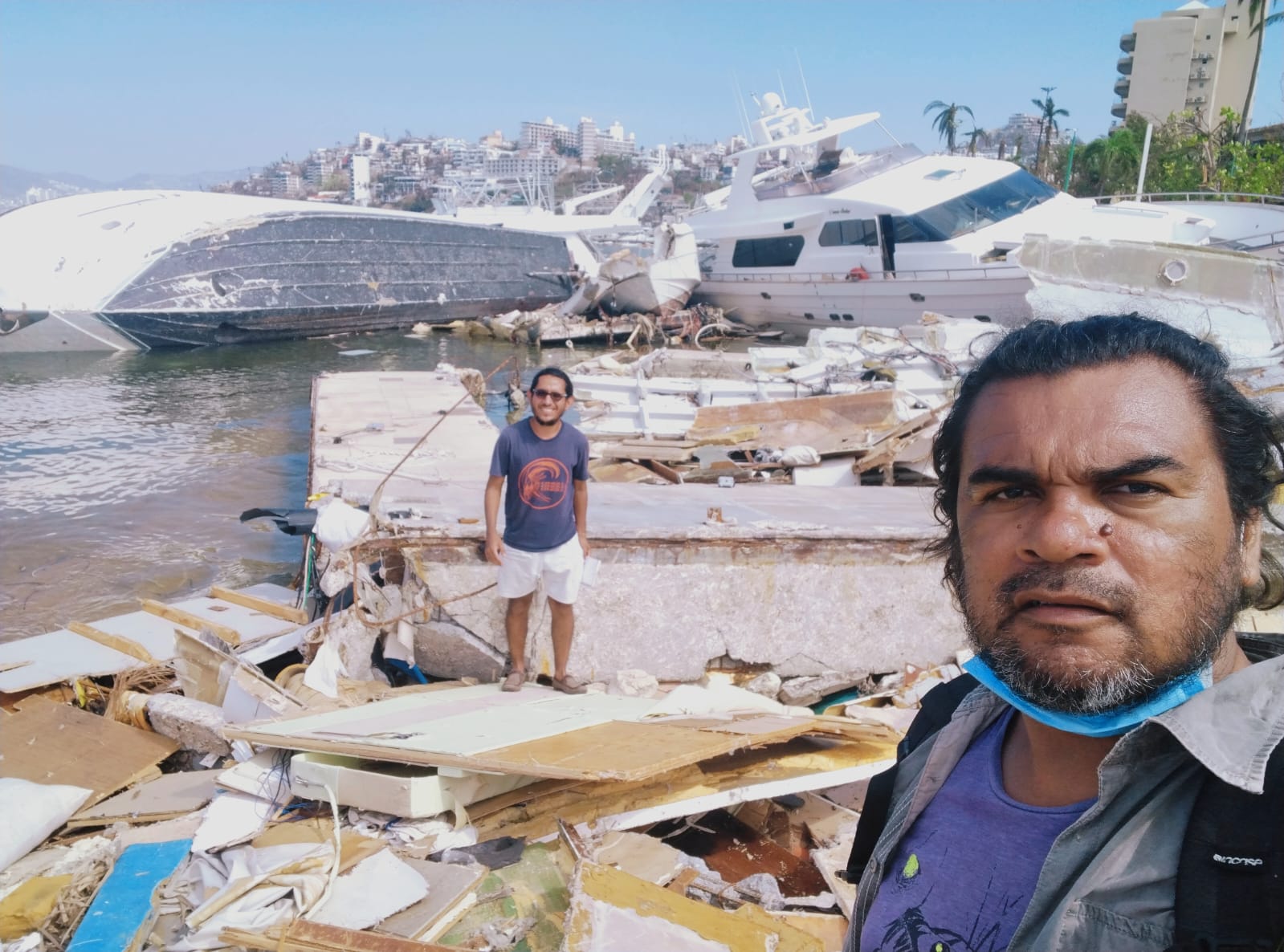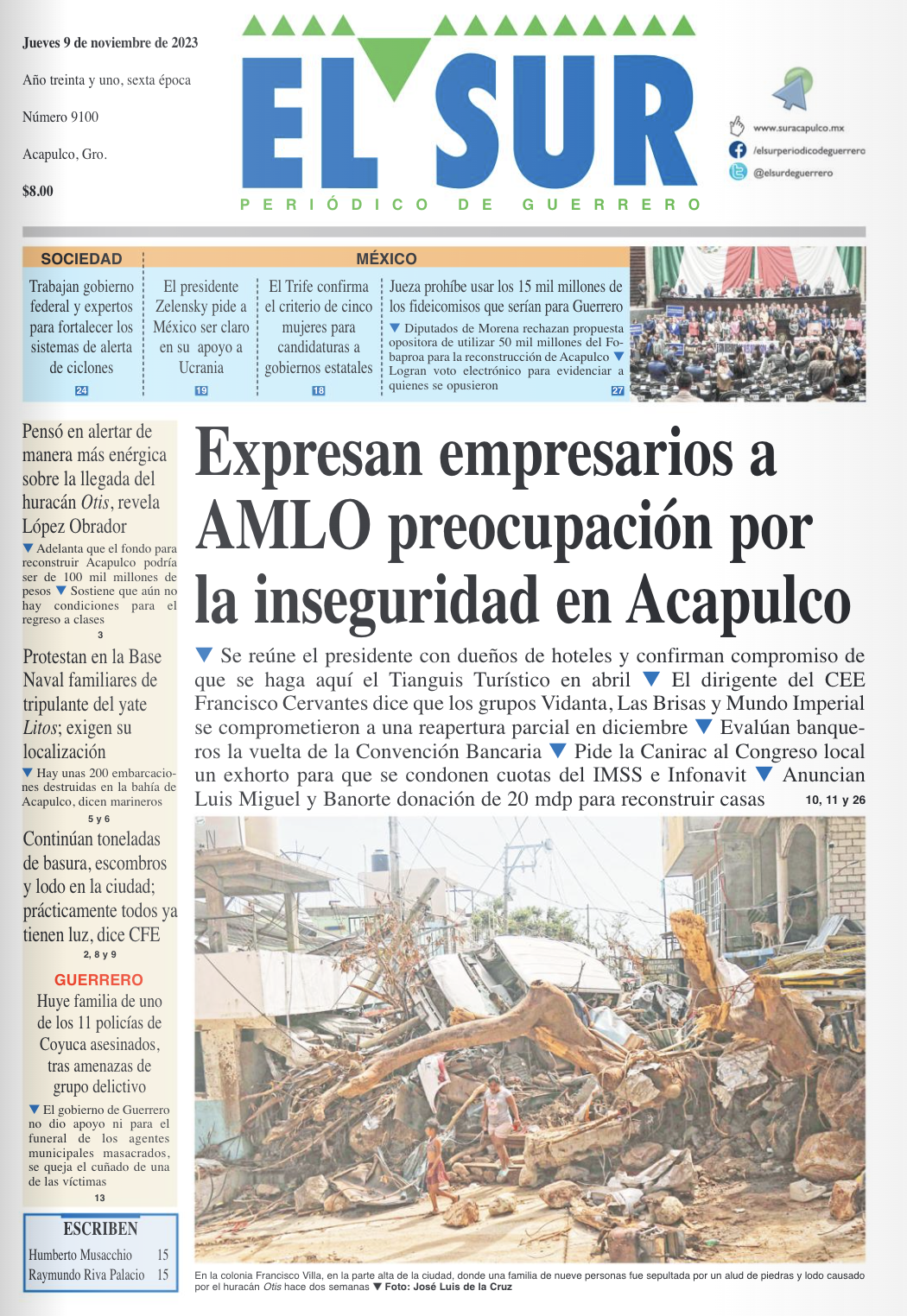Following Hurricane Otis’ strike along the coast of the state of Guerrero, Mexico, in the early hours of Oct. 25, photojournalist Carlos Carbajal found himself unable to work, with his photographic equipment damaged and his home in the port of Acapulco severely affected, without electricity or internet.
Carbajal spent several days looking for places with power and mobile data to edit the material he gathered as soon as the hurricane's strong winds and rain stopped, and send it to his editors at El Sur, the newspaper where he’s worked for 12 years. Along with other reporters from Acapulco, he tried to do his work in shopping malls and restaurants where they were allowed to set up temporarily, while everything around them was destroyed.
"There is a shopping mall called La Gran Plaza and first they lent us a space there, by the entrance. They told us 'you can set up there,' but then they took it away from us," Carbajal told LatAm Journalism Review (LJR). “Then someone from a restaurant said 'you can be here,' but they only let us stay for one day. Then they moved us outside a McDonald's, on those little benches that hadn’t crumbled. We were working there, but among garbage, among waste, among dead animals... In other words, it was horrible.”

After Hurricane Otis left most regions of Acapulco without power, journalists gathered in the outdoor area of a restaurant to work. (Photo: Luis Daniel Nava)
One month after what has been considered the strongest hurricane in the eastern Pacific since records have been kept, conditions for journalists have not improved much. Journalists' associations are urging support in the face of the critical situation their colleagues are confronting. Journalists in Guerrero are facing multiple obstacles to do their work, which brings with it the risk of an information vacuum and the threat of local media disappearing due to the impossibility of continuing to publish.
"Many of these communicators and journalists live hand-to-mouth, they live from the information they send to some portals now and then that pay them per story, because they are freelancers," Aníbal Muñiz, spokesman for the Mexican Association of Displaced and Attacked Journalists (AMPDA, by its Spanish acronym), told LJR. "The moment they run out of electricity and have no internet, they can't work, they can't do their reporting, and they have no formal employment that gives them a steady income."
After the passage of Otis, Acapulco’s communications were cut off, and the rest of the country had no reliable news of the effects of the hurricane. With roads closed due to mudslides and flooding and the local airport severely damaged, it took several days for the national media to arrive to report. And local journalists struggled to find ways to get information and images back to their newsrooms, while dealing with their personal and property losses.
"There is a lot of journalistic work to be done, but it’s complicated because still two weeks later, many streets, especially on the outskirts of Acapulco, are still blocked, impassable due to felled trees, dirt mounds," journalist José Nava Mosso, director of the Guerrero News Agency, told LJR. “Most journalists’ families and property were affected. Their cameras, video cameras, computers, and other tools they use to communicate were also damaged.”
Despite having suffered material losses, Carbajal said he did not stop working for a single day during the two weeks following the hurricane. As long as his cell phone battery would allow him, he captured yachts turned upside down, cars piled one on top of the other by strong winds and even the bodies of lifeless people in the streets of Acapulco. He was not able to send this material to his newsroom until several days later, when he gained access to the Internet.
One month later, neither telecommunications nor electricity have been fully restored. The internet signal is intermittent and can only be picked up in some regions. The Costera Miguel Aleman, Acapulco's main tourist road, was one of the first areas to have good cell phone coverage. That is where reporters and photographers must go to send their material, he said. It was also on that avenue where Carbajal first heard from his colleagues.
"My cell phone battery lasted two days and on the third day, some Univision colleagues who had a big car with an antenna, with hookups, began to give people a chance to plug in there. I plugged in there for a few minutes to charge my cell phone," he said.
"The municipality of Acapulco, on the fourth day, set up a generator to charge reporters’ cell phones. That was when several of us reporters began to congregate and we began to get news about each other."
The insufficient journalistic coverage caused a news vacuum in Acapulco and other affected municipalities. Some journalists and local digital media managers moved to nearby cities to work remotely, but with a shortage of telecommunications services, reporters on the ground still face obstacles in getting information out.

Photojournalist Carlos Carbajal (right) lost his photo equipment to the cyclone, but used his cell phone to document the devastation. (Photo: Carlos Carbajal).
"We are technically limited. In my case, I did come to Chilpancingo [Guerrero’s state capital]. The others there are stranded [in Acapulco] and they publish information when they can, and when they can't, they wait until they get a signal," Miguel Ángel Mata, president of the Journalists' Club of Guerrero and director of the digital news outlet Síntesis de Guerrero, told LJR. “There is an information vacuum because they are only publishing press releases from politicians and government entities, showing photographs of them cleaning only the Costera Miguel Alemán [...]. When we publish this information we do it in a very limited way, precisely because of this lack of power.”
For many of the journalists who suffered damage to their homes, this also meant a workplace loss. As a result of the COVID-19 pandemic and damage caused by the frequent earthquakes affecting the region, El Sur closed its offices in Acapulco about two years ago, Carbajal said. Since then, most of the newspaper's journalists have been working from home.
"There is another office that we call 'The Shop,' which is where the newspaper is printed. Those offices are there, but they were badly damaged [by Hurricane Otis]. Now the bosses have come and they are looking for a way to fix the place so that we can work there," Carbajal said. "But that only worked for two days because we didn't have electricity yet again today, so now we’re looking for a place to send out information."
The devastation of Hurricane Otis came on top of a long list of factors that have kept journalism in Guerrero in a critical situation. Even before the cyclone, the state was already a highly hostile scenario for journalists, due to murders, threats, forced displacement, attacks and lack of safety.
So far in 2023, at least three journalists have been murdered in the state. In Acapulco alone this year, reporter Gerardo Torres Rentería and crime beat reporter Nelson Matus were killed in May and July, respectively. In June, radio broadcaster Pablo Salgado was murdered in the city of Iguala, 130 miles from Acapulco.
On Nov. 17, the organization Article 19 said that, according to its most recent report on violence against the press in Mexico, Guerrero continues to be among the 10 most violent states for journalistic work in the country. It also denounced the persistence of threats and acts of intimidation against journalists by organized crime, especially in Iguala, a hotspot in the state due to its high levels of violence.
Impunity in cases of violence against journalists and the inaction of state authorities has created an atmosphere of helplessness that has had an impact on the practice of journalism and the emotional health of journalists, Article 19 said in its statement.
"Some of them have been forced to resort to self-censorship: to stop collaborating in their media outlets, lower their profile and/or limit their posts [on social media]. This affects their right to freedom of expression and the right of access to information for the people of Iguala and the state of Guerrero in general," the organization said.
Added to this outlook is the concern of Acapulco journalists that the devastation left by Otis will provoke a crisis that will lead to the closure of local news outlets, especially those that depend on government advertising.
"I believe that yes, some are going to disappear, because the government signs agreements with some media, with most," Mata said. “Now that they are not publishing, they run the risk of having their agreements canceled and their source of financing cut off.”
Carbajal believes that among his colleagues in Acapulco there is uncertainty as to whether the needs left by the hurricane will overcome the government's capacity and this will cause cuts in official advertising budgets to local media.
"It’s something that worries us a lot, that it’s likely that many news outlets will not survive that, especially because the resources that are still there come from institutional advertising," he said. "I don't know how it's going to be done, if all [the public budget] is going to be concentrated in other types of aid to the city, there could be a cut in state advertising for the media."
In view of the desolate outlook left by Otis, journalists' organizations and organizations defending freedom of expression in Mexico have called on federal authorities and the state of Guerrero to take action to support journalists affected by the hurricane and to guarantee the right to information of the population in the midst of a disaster.

Some Acapulco media staff have moved to other cities to be able to work, while reporters in the disaster zone face obstacles to do their work. (Photo: El Sur)
The organization Displaced Journalists of Mexico urged the governor of Guerrero, Evelyn Salgado, to allocate resources from the Support Fund for Journalists that the state has to support the affected journalists with their most pressing needs, according to a statement published on social media on Nov. 3.
Similarly, the Journalists' Club of Guerrero and the Guerrero branch of the National Union of Press Editors (SNRP) met with state authorities to request that resources from said fund be delivered to journalists in Acapulco.
"We are asking that at this time resources [state government] be released so that our colleagues in Acapulco be given an amount of money," Mata said. "We believe this resource is enough to provide our colleagues with some resources [for] one, two or three weeks. We believe this is viable.”
Article 19 urged Mexican authorities to guarantee the right to information in the areas affected by the impact of Otis, after, according to the organization, Mexican authorities failed to provide clear and timely information on the magnitude of the hurricane, which left the population unable to make informed decisions and prepare for the natural phenomenon, according to a statement published on Nov. 1.
The Journalists Club and the SNRP are collecting food and economic support among their members to take to their colleagues in Acapulco and other affected municipalities. The organization Frontline Freelance MX, which supports freelancers, called for donations of work equipment such as batteries, extension cables, lamps, and memory cards.
The AMPDA, for its part, called on journalists and news outlets in Mexico to donate equipment in good condition to reporters who lost their work tools.
"If you have an old camera in good condition, donate it. Or a laptop, a tape recorder or a telephone," Muñiz said. "Any of those tools will help, because [with that] you can go back to reporting. And now that you can report, you can send a story, send photos, maybe you can do an interview, and that will mean income.”